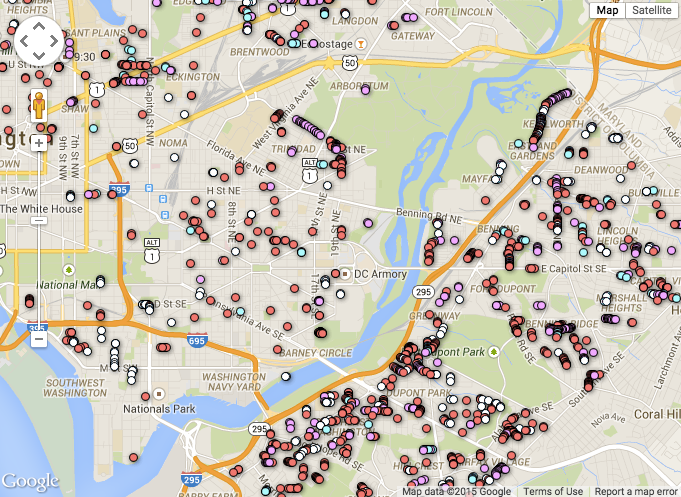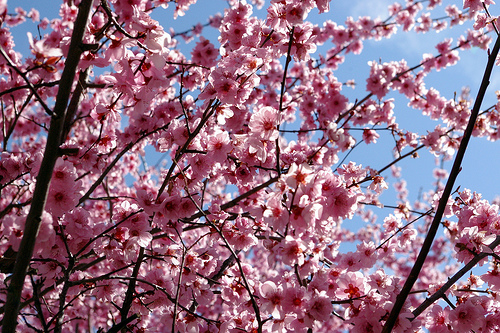The forecast today may be calling for snow but it is, in fact, the first day of spring. And in D.C., spring means cherry blossoms. While that also means insane crowds of tourists, there is another way.
Take a look at the map below, from Casey Trees. All those dots are cherry trees, and there are tons right in our neighborhood. Even better, these different types of trees bloom at different times, which means that there are plenty of beautiful sights to enjoy after the trees around the Title Basin have lost their flowers.

White dots are the familiar Yoshino cherry trees, turquoise dots represent snow goose cherry trees, pink dots mark the location of the pink double-blossomed Kwanzan cherry trees (which bloom about two weeks after the Yoshino), and red dots signify all other cherry trees, which include black cherry, edible cherry, Okame cherry and weeping cherry trees.
The peak bloom date that everyone talks about is defined as the day when 70% of the Yoshino Cherry blossoms are expected to be open. They tend to stay open for several days, depending on weather. The Kwanzan variety blooms about two weeks later than the Yoshino. The NPS website explains more about the different types and how their bloom times and colors vary:
The Yoshino cherry tree is the predominant variety that encircles the Tidal Basin and spills north onto the Washington Monument grounds. The Yoshino trees produce a great profusion of single white blossoms that create the effect of white clouds banked around the basin. The Yoshino, known as Somei-yoshino in Japan, is a hybrid of unknown origin that first was introduced in Tokyo in 1872 and is now one of the more popular cultivated flowering cherries. Mingled with the Yoshino trees is a small number of the Akebono cherry trees, a mutation of the Yoshino tree with single, pale-pink blossoms, introduced into cultivation by W.B. Clarke of California in 1920. The Akebono tree flowers at the same time as the Yoshino and provides an attractive tint of pink in the early stages of the peak bloom.
The Kwanzan cherry tree, named after a mountain in Japan, is growing primarily in East Potomac Park. Coming into bloom two weeks later than the Yoshino, the upright Kwanzan branches bear heavy clusters of clear pink double blossoms. The cultivars Fugenzo (double, rosy pink flowers) and Shirofugen (double white when open but aging to pink) also are represented. Fugenzo is the cultivar Mrs. Helen Herron Taft believed she planted even before she officially planted the first tree from Japan in 1912. They were planted along the Potomac River from the present site of the Lincoln Memorial southward toward East Potomac Park; they gradually disappeared. As First Lady, Mrs. Taft became interested in the beautification of a particular Potomac Park area, known then as the “Speedway” surrounding the Tidal Basin.
The Weeping Japanese Cherry tree, sometimes called the Higan cherry tree, is interspersed among the Yoshino, Akebono, and Kwanzan trees. The flowers of the Weeping Cherry are variable, giving rise to many different forms (single to double) and flower colors (dark pink to white). They flower about one week before the Yoshino trees.
The warm weather really is almost here so get those walking shoes and get ready to explore the neighborhood in its spring glory.

